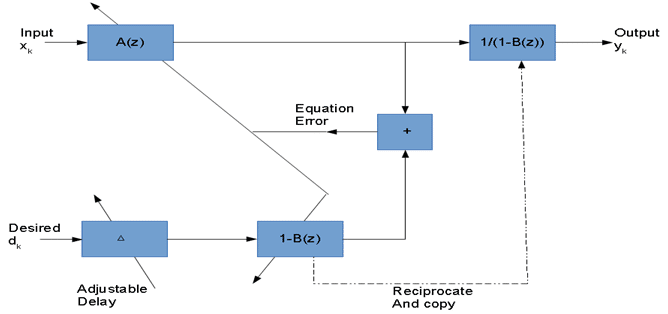Broadband beamforming processing can be interpreted as using an all-zero digital filter to generate a frequency-dependent magnitude and phase shift over the operational bandwidth of the array [2]. Gooch has previously shown that adaptive poles and adaptive zeros can support and enhance adaptive beamforming performance [2]. A primary component of the wideband adaptive beamformer is an adaptive filter. The filter to be used in this case is an IIR adaptive filter as shown in Figure 1.
Figure 1: IIR adaptive filter [1]
The transfer function of this IIR filter is given by:
A(z)/(1 – B(z))
Both A(Z) and B(Z) are varied to minimize the mean square error of the equation error as shown in Figure 1: The output signal results from a filter with a transfer function as
1/(1 – B(z))
The filter parameters are obtained by reciprocating the known transfer function of the 1 – B(z) filter [1]. There are cases where one or more of its poles become outside the unit circle. The adjustable delay ∆ is varied until 1 – B(z) has minimum phase. This condition will cause all zeros to be inside the unit circle. The desired signal dk is realized by averaging all array sensor inputs on a sample by sample basis.
The improved performance of this beamformer is a result of deeper and sharper nulls created by adapting weights with adaptive poles and zeros when compared with zero only adaptive weights. The IIR adaptive filter can be applied to and improve the performance of the Frost and Griffiths-Jim beamformer. The Frost beamformer is an adaptive beamformer with a structure that is very similar to a delay and sum beamformer. Each microphone is filtered by a FIR filter with weights.
This software package can include options to be applied to enhance the null performance of adaptive beamformers. The beamformer software package contains a beamforming algorithm to dynamically steer a beam at the source location. Our beamforming solution can include a source localization algorithm to provide the beamformer with the source location coordinates. At VOCAL Technologies, we will customize your beamforming solution for your specific application. Contact us to discuss your application requirements.
More Information
References
[1] B. Widrow and S, Stearns, ”Adaptive Signal Processing,” Englewood Cliffs, New Jersey, Prentice-Hall, Inc., 1985.
[2] R. P. Gooch, “Adaptive pole-zero array processing”, Proc. 16Th Asilimar Conf. Circuits Syst. Comput., Nov. 1982.
